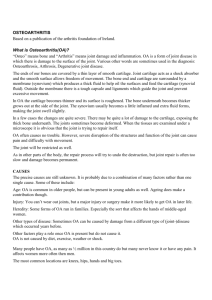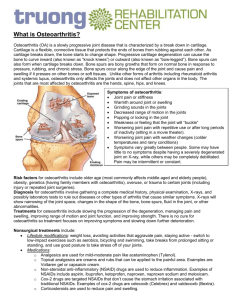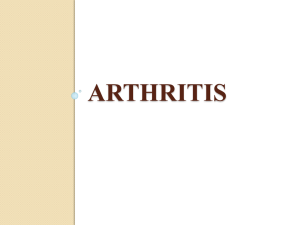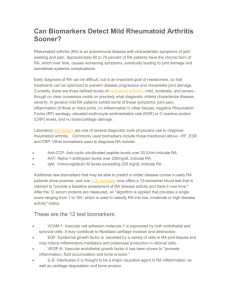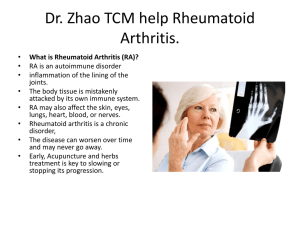Rheumatoid Diseases
advertisement
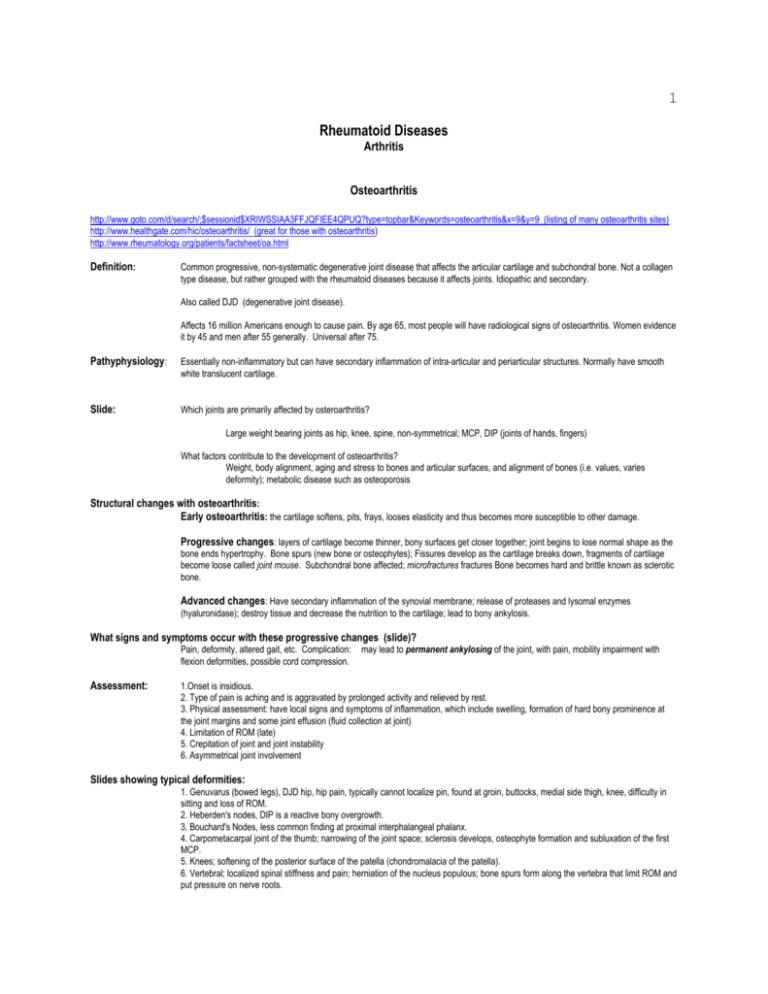
1 Rheumatoid Diseases Arthritis Osteoarthritis http://www.goto.com/d/search/;$sessionid$XRIWSSIAA3FFJQFIEE4QPUQ?type=topbar&Keywords=osteoarthritis&x=9&y=9 (listing of many osteoarthritis sites) http://www.healthgate.com/hic/osteoarthritis/ (great for those with osteoarthritis) http://www.rheumatology.org/patients/factsheet/oa.html Definition: Common progressive, non-systematic degenerative joint disease that affects the articular cartilage and subchondral bone. Not a collagen type disease, but rather grouped with the rheumatoid diseases because it affects joints. Idiopathic and secondary. Also called DJD (degenerative joint disease). Affects 16 million Americans enough to cause pain. By age 65, most people will have radiological signs of osteoarthritis. Women evidence it by 45 and men after 55 generally. Universal after 75. Pathyphysiology: Essentially non-inflammatory but can have secondary inflammation of intra-articular and periarticular structures. Normally have smooth white translucent cartilage. Slide: Which joints are primarily affected by osteroarthritis? Large weight bearing joints as hip, knee, spine, non-symmetrical; MCP, DIP (joints of hands, fingers) What factors contribute to the development of osteoarthritis? Weight, body alignment, aging and stress to bones and articular surfaces, and alignment of bones (i.e. values, varies deformity); metabolic disease such as osteoporosis Structural changes with osteoarthritis: Early osteoarthritis: the cartilage softens, pits, frays, looses elasticity and thus becomes more susceptible to other damage. Progressive changes: layers of cartilage become thinner, bony surfaces get closer together; joint begins to lose normal shape as the bone ends hypertrophy. Bone spurs (new bone or osteophytes); Fissures develop as the cartilage breaks down, fragments of cartilage become loose called joint mouse. Subchondral bone affected; microfractures fractures Bone becomes hard and brittle known as sclerotic bone. Advanced changes: Have secondary inflammation of the synovial membrane; release of proteases and lysomal enzymes (hyaluronidase); destroy tissue and decrease the nutrition to the cartilage; lead to bony ankylosis. What signs and symptoms occur with these progressive changes (slide)? Pain, deformity, altered gait, etc. Complication: flexion deformities, possible cord compression. Assessment: may lead to permanent ankylosing of the joint, with pain, mobility impairment with 1.Onset is insidious. 2. Type of pain is aching and is aggravated by prolonged activity and relieved by rest. 3. Physical assessment: have local signs and symptoms of inflammation, which include swelling, formation of hard bony prominence at the joint margins and some joint effusion (fluid collection at joint) 4. Limitation of ROM (late) 5. Crepitation of joint and joint instability 6. Asymmetrical joint involvement Slides showing typical deformities: 1. Genuvarus (bowed legs), DJD hip, hip pain, typically cannot localize pin, found at groin, buttocks, medial side thigh, knee, difficulty in sitting and loss of ROM. 2. Heberden's nodes, DIP is a reactive bony overgrowth. 3. Bouchard's Nodes, less common finding at proximal interphalangeal phalanx. 4. Carpometacarpal joint of the thumb; narrowing of the joint space; sclerosis develops, osteophyte formation and subluxation of the first MCP. 5. Knees; softening of the posterior surface of the patella (chondromalacia of the patella). 6. Vertebral; localized spinal stiffness and pain; herniation of the nucleus populous; bone spurs form along the vertebra that limit ROM and put pressure on nerve roots. 2 Diagnostic tests: None specific. X-ray in the late stages will show joint space narrowing, bony sclerosis, spur formation and perhaps subluxation; MRI to conform Ct and xrays. Synovial fluid aspiration will evidence increased volume, clear and yellow in appearance and without evidence of inflammation or just minimal. Gait analysis; muscle testing (weakness of muscles supporting joints) Nursing Diagnosis: Will depend on manifestations. Interventions: Will depend upon complications. Supportive care: Cane or walker to decrease pressure and strain on joints; decreased weight, etc. Medical treatment: No specific therapies other than those directed at preventing complications and reducing pain. Goals to achieve comfort prevent progression of disease and disability and to restore joint function. Medications include ASA, NSAID (maybe twice daily), intraarticular injections of steroids, but avoid systemic corticosteroids; antiinflammatory; muscle relaxants to relieve muscle spasms; NSAID. Dietary will include weight reduction if overweight. Surgery will depend upon resulting disability (joint replacement, especially hip and knee) Nursing management focuses on health promotion and maintenance Teaching includes medication use, rest and support of affected joints, decrease weight, proper use of moist heat, splints, orthotics, assistive devices, follow-up care. Long-term management requires use of good body mechanics, use of assistive devices if indicated safety, surgical replacement, weight management, and comfort measures. Rheumatoid Arthritis http://www.duq.edu/PT/RA/TableOfContents.html (if you don’t do any other sites, please visit this one! Excellent!!!) http://www.rheumatology.org/patients/factsheets.html (comprehensive fact sheet for all types of rheumatoid diseases) http://members.aol.com/_ht_a/REDAPRIL4/index.html (discusses CREST Syndrome, a condition that may accompany RA_ Rheumatoid Arthritis: Chronic systemic, inflammatory disease characterized by recurrent inflammation of diarthroidal joints and related structures. Over 100 types of connective tissue diseases with joint manifestations and include RA, SLE, scleroderma, JR, polymyositis, and dermatomyositis. RA& Osteoarthritis comparison: How do these disease processes differ and how are they alike? 1. RA: cause unknown 2. Periods of remission 3. Body part affected: small joints 4. Symmetrical joint involvement 5. Age: 20-30 6. Females Manifestations: 1. OA “wear and tear” 2. Progressive 3. Body parts affected, large weight bearing 4. Non-symmetrical 5. Middle-age, elderly 6. 2:1 males Multiple body systems affected Hematologic, anemia Pulmonary, with pleuritis, interstitial fibrosis, pneumonitis, pleural effusion; caplan's syndrome with rheumatic nodules and cavitation in the lungs. Neurologic with localized neuropathy, foot drop and spinal cord compression. Ocular with Sjögren "dry eye" syndrome with decreased lacrimal and salivary gland secretion (becomes like sand); dryness of all mucous membranes. Cardiovascular with fibrosis, 10% have pericarditis, cardiomyopathy, and vasculitis that is inflammation of all small vessels and can cause widespread damage. Integumentary with thinning of the skin Numerous joint deformities Rheumatic nodules firm non-tender subcutaneous nodules at the extensor surface of the forearm and olecranon bursae, back of spine and back of neck; may appear and disappear insidiously. PAIN! 3 Assessment: 1. 2. 3. 4. 5. 6. 7. 8. 9. Fatigue Weakness Pain, arthralgia, myalgia Joint deformity Rheumatic nodules Fever Joint swelling Bladder dysfunction. Other systemic illnesses Pathophysiology: Infection may trigger; genetic factors play a role; altered immune response. Antibody molecule IgG (Immunoglobulin G (principle antibody of secondary humeral immune response) reacts with RF (antibody-like protein molecules that are produced in response to alterations in connective tissue gamma globulin). The RF and IgG form an antigenantibody complex, which precipitates in the synovial fluid causing an inflammatory response. Polymorphonuclear leukocytes are attracted to these complexes in the joints and ingest the immune complexes. However when lymphocytes enter the joint, they do not differentiate between the antigen and the healthy tissue and so they attack the synovial lining . Phagocytic action by lymphocytes causes lyosomal enzymes to be released and destroy cells of the joint lining. Joint Changes with RA (slide x2) Normal knee (smooth, non-inflammatory) Early pannus formation: Granulation inflammation stage, which occurs at the junction of the synovium and cartilage. Extends over the surface of the articular cartilage and eventually invades the joint capsule and subchondral bone; cartilage softens, weakens, and is destroyed. Prostaglandin which is produced by the WBC when the immune complexes are encountered; increases cell permeability. Thus swelling increased Moderately advanced pannus: joint cartilage disappears and subchondral bone destroyed. Joint space is decreased and the joint surfaces collapse and joints subluxate. Fibrous ankylosis: fibrous connective tissue replaces pannus; loss of joint motion Bony ankylosis: bone replaces fibrous tissue; no joint motions, less pain! Joint calcification Diagnostic Tests: No single lab test is conclusive Moderate anemia Elevated ESR (85%) and monitor response by this test Latex agglutination test is positive for RA RA factor (circulating antibody of immunoglobulin M) is present in titer of 1:160 in 80%. ANA and LE cells positive in small number of cases (20%). Synovial fluid show increased volume and turbidity but decreased viscosity. X-ray reflects bony demineralization and soft tissue swelling during first 6 months and then decreased joint space, destruction of joint cartilage. Common deformities/Joint Changes (slides) Effects on PIP and MCP joints; tapering fingers; ulnar deviation; tender, red swollen joints Swan neck Boutonniere Tenosynovitis Multans Deformity Subcutaneous Nodules Genu Valgum (Knock knee, due to joint subluxation due to weak ligaments, then destruction of the cartilage.) Pes Plano Valgus Flat foot and calcaneal valgus Prominent Metatarsal Heads Hallus valgus Hammer toes Nursing Diagnosis: Comfort Impaired self-image Impaired physical mobility *Pain 4 Interventions: Goals are to maintain function, provide psychological support and utilize appropriate treatment modalities. Team approach: multi disciplines, family involvement needed Pain management: numerous treatment modalities including heat and cold therapy, paraffin therapy: Proper positioning: splinting for proper body alignment planned rest Teaching: Posture: good body alignment, firm mattress, lying prone, no pillow at knee and flat pillow to head. Exercise guidelines Use of large joints Joint protection. Prevent ulnar deviation Surgery : Joint replacement; synovectomy Nutrition: No special foods, just well balanced diet. Medications ****Review in text! ASA are the cornerstone, anti-inflammatory. Side effects include upset of stomach, ringing in the ears and GI bleed should be taken with food. Nonsteroidal anti-inflammatory drugs relieve pain and inflammation by prostaglandin inhibition. Some of these drugs include Motrin (ibuprofen), indomethacin (indocin) which causes GI irritation and rash; nalfon, Naprosyn, clinoril which causes fluid retention; feldene that may also cause GI irritation, headache, dizziness, rash, anemia, fluid retention. Take with food. Steroids interfere with the body's normal inflammatory response, but have serious side effects including fluid retention, loss of potassium, hypertension, and susceptibility to infection, GI irritation, osteoporosis, and adrenal insufficiency. They cannot rapidly be stopped and should be taken with food, mild or antacid. ACTH and Butazolidin are used along with prednisone. Bridge therapy or use of steroids may be employed until longer acting drugs take effect in 4-6 weeks. May also use burst corticosteroid, which is high dose of steroids for severe flair, and then taper off over 10-14 days. Monthly pulse therapy may be employed for control as it has fewer side effects and includes solu-medrol with 1-gram/day IV times 3 days. Remitting agents are slow acting and suppress the inflammation. Antimalarial include plaquinal (hydroxchloroquinine), aralen, atabenne. These react with DNA to suppress lymphocyte responses, can cause serious eye effects, GI disturbances. It is usually after gold therapy. Penicillamine (cuprimine), works like gold. It may inhibit collagen synthesis or alter lymphocyte reaction and prostaglandin; numerous side effects including fever, skin rash, nephrotic syndrome, GI irritation, lupus, allergic, reaction if sensitive to penicillin and decreased wound healing. Penicillamine must be taken on an empty stomach. Chrysotherapy or gold therapy. Myochrysine uses water for injection and inhibits phagocytosis and immune globulin levels, but takes 3-6 months to work. Solganal uses oil as base. Have new oral agents. These drugs require blood and urine testing deep in administration, may cause rash, itching, mouth sores, metallic taste in mouth. Immunosuppressive agents affect production of antibodies at the cellular level. These drugs include Cytoxan (leads to bone marrow depression, toxic, GI irritation, alopecia, oral lesions, dermatitis, blood dyscrasia, and bone marrow depression. Also use methotrexate that can lead to GI disturbances, infertility, hepatic lesions, etc. Case presentation (Ann Steele) 5 Systemic Lupus Erythematous http://www.barryd.com/ (home page of individual with lupus) http://www.mayohealth.org/mayo/9605/htm/lupus.htm (good site for patient and family information) http://familyvillage.wisc.edu/lib_lups.htm http://www-medlib.med.utah.edu/WebPath/TUTORIAL/SLE/SLE.html (includes pathology of lupus) Definition: Chronic multisystem disease involving vascular and connective tissue resulting in biochemical changes that lead to structural changes and inflammation; aberration in immune system in which immune complexes are deposited in tissues. Antigen-antibody reaction can be directed against many normally occurring antigens (DNA), platelets, clotting factor, cell membrane, any blood vessel, etc. Characteristics of SLE Types: Discoid Lupus Erththematous: Cutaneous form of the disease. Characterized by raised, scaly red patches especially on face, and irregular areas of alopecia. Systemic Lupus Incidence: all ages, average is 30; women 9:1; most develop disease in childbearing years. Hormones a factor; black will develop more often; genetic pre-disposition Characterized by periods of remission and exacerbation Stress a factor *Characterized by periods of remission andexacerabation. Stimulated by sunlight, stress, and pregnancy and some drugs including apresoline, pronestyl, dilantin, tetracycline and Phenobarbital which may cause a lupus-like reaction. Assessment: Family history, multisystem involvement: (slide) 1. Low grade fever, decreased weight. 2. Dermis with discoid erythremia (90%), palmer erythema, alopecia, Mucosol ulcers. Butterfly rash...disappears, leaves pigmentation. 3. Musculoskeletal involvement. Polyarthalgia no joint deformity, arthritis, synovitis and myositis. 4. Cardiopulmonary. Pericarditis in 50% pleural effusion. Raynaud's phenomena with vasospasm of small vessels in cold. May lead to amputation. 5. Renal. Leading cause of death. Associated with glomerulonephritis, proteinuria. 50% have cellular casts, urine sediment, proteinuria, elevated serum creatinine, hematuria. 6. Hematopenic, pale, anemic, leucopenia. 7. CNS. Close behind kidney as cause of death, seizure, organic brain syndrome, CVA. 8. General. Conjunctivitis, hair, dry and bridle. 9. Digestive, nausea, dysphagia, diarrhea, abdominal pain. 10. Infection have increased susceptibility 11. Reproductive 12. Vascular abnormalities with abnormal bowel sounds, numbness, tingling and peripheral neuropathy. Typical features 1. 2. 3. Musculoskeletal involvement, pain and swelling, non-deforming Chronically ill Raynauld’syndrome Diagnostic Tests: . See text. 1. Le cell: Abnormal appearing cell on blood smear. 80% people have it. Found during acute episode. Less sensitive test 2. A NA (auto-antibodies): ANA is harmless in themselves, but form antigen-antibody complexes that cause tissue damage. If antibodies are present, need to test further to determine the type of ANA circulating. A screening test, not specific. Higher the titer the greater the degree of inflammation. It is positive in 99% persons with SLE (1:256 is positive and 1:32 is negative). Very sensitive test; but not specific for SLE as 5% normal people have it and 38% of all persons over 60. 3. Anti DNA is most specific for lupus. 60% with SLE have it especially when have renal involvement 4. RA factor 35% positive without disease 5. Serology false FTA-ABS which is the flourescent treponemal antibody 6. Complement fixation measures the amount of free floating complement circulating in the blood. It is the protein substance that binds with the antigen-antibody complexes for purposes of lysis. When the number of complexes increases markedly, complement is being used for lysis and thus decreases the amount of available in the blood. With active RA, SKE the amount of free complement is decreased. 6 7. ESR: Rate the RBC settle out of unclotted blood in one hour. Indicates increase in inflammation. 8. Other: HCT, often a normocytic, normochromia anemia without bleeding. CBC with decreased platelets. Spinal fluid with decreased WBC, increased protein, and increased mononuclear cells. Urine shows hematuria, proteinuria, elevated serum creatinine, creatinine clearance. Chest xrays show pleural effusion, etc. *Criteria for dx. SLE: (must have four or more of the above present, serially or simultaneously, during any interval of observation; Malar rash Discoid rash Photosensitivity Oral ulcers Arthritis: nonerosive, involvement of two joints or more Serositis: pleuritic or pericarditis Renal disorder proteinuria or cellular Hematologic disorder: hemolytic anemia, leukopenia, lymphopenia, or thrombocytopenia Immunological disorder: positive lupus cell preparation; Antibodies to native DNA or antibody to SM nuclear antigen; false-positive Serological test for syphilis Antinuclear antigen. Management of SLE Nursing diagnosis: Pain, alteration in body image; role conflict, knowledge deficit, impaired skin integrity; altered home maintenance * Infection; cause of death in 30% of cases Interventions: Goal is to control inflammation. Medications: same as RA; corticosteroids; ASA, NSAID, immunosuppressive agents. May require plasmapharesis, if lifethreatening Teaching: Life-planning, stress reduction, prevention of complications. Emotional: support groups vital! Progressive Systematic Sclerosis Scleroderma http://www.mayohealth.org/mayo/9705/htm/sclero.htm http://www.angelfire.com/ri/scleroderma/ (good sites for lots of scleroderma information) Definition: (slide) Progressive systematic sclerosis (hardening) of skin; Found in females in 4:1 ratio, affects ages 30-50; cause is unknown Starts with skin involvement, at first inflammation with edema and then the skin becomes taut, smooth, shiny and then with fibrotic changes. Tissue degenerates and is not functional. Results in tissue death! CREST Syndrome: benign varient of the disease: calcinosis, Raynauld’s disease, esophageal hypomotility, sclerodactyl, telangiectasia Physical Assessment: Identify pain, stiffness, polyarthritis and severe muscle weakness. Detect taut, "hide-bound" skin, without wrinkles, very dry; may be swelling, puffiness of fingers, hands, face is mask-like and rigid; extremities are stiff, with claw like fingers. Hypertension, joint effusion Internal changes not visible with fibrosis and esophageal hardening and scarring of the lungs; often Raynaud's syndrome (90%) and telangiectases (small red skin lesions due to blood vasodilitation Nausea, vomiting Cough *Pleural thickening, pulmonary fibrosis *Renal involvement and potential cause of death *Esophageal reflux 7 Diagnosis and treatment 1. 2. 3. Determine if auto-immune disease; same tests as for RA,SLE Radiological finding: pulmonary fibrosis, bone resorption, subcutaneous calcification, distal esophageal hypomotility, skin changes Key components to care: Med: Antacids/anti-inflammatory; remitting agents to decrease solubility of the dermal collagen. May also use colchicine which decreases collagen. Steroids generally not employed unless other problems. Also antihypertensives, broad-spectrum antibiotics, vasodilator. Physical therapy and occupational therapy are important for ROM and maintenance of functional abilities. Ointments for skin ulcerations and to keep skin as pliable as possible. Periodic dilations for esophageal strictures. Management is primarily supportive. Decrease stress, avoid cold use gloves. No fingerstick. Health teaching very important. Promote improved self image. Small frequent feedings, sit upright, use antacids, good oral hygiene. Job modification. Protection of fingers. Daily oral hygiene. Biofeedback, relaxation. Administration of medications as analgesics. No smoking, exercise, heat therapy. Ankylosing Spondylitis Marie Strempel Disease http://www.rheumatology.org/patients/factsheet/as.html Definition: Known as infections polyarteritis of the spine; chronic inflammatory disease affecting the sacroiliac joints, costovertebral joints of the spine and adjacent soft tissue. May lead to deformity and ankylosis of affected bones, primarily spine Incidence: 90% of those with ankylosing spondylitis are Anglo and are HLA-B27 positive It affects adolescents, young adults, especially men, and there is a family tendency. Signs and Symptoms: Insidious onset in adolescent or young adult with morning backache in lumbar area and both sacroiliac joints, with stiffness and ache in these areas. Activity decreases the pain and stiffness, gradually worsen, to severe muscle spasm, causing pull vertebral column forward into flexion. Rounds back. Eventual ossification Fever and anorexia are rare. Eventual decreased chest expansion, bent posture, hip flexion, spine subluxation Diagnosis: Early elevations of the ESR Elevations of alkaline phosphates and 17-ketosteroid levels RBC decreased; WBC elevated HLA-B27 antigen RA factor (generally negative) Decreased vital capacity Late x-ray evidence of narrowing of the sacroiliac joint and a "bamboo" spine appearance Nursing Diagnosis: Impaired respiratory function, pain, altered self-image Management: Cannot prevent, but KEY to control inflammation, and pain, deformity and prevent respiratory impairment Maintain maximum spine mobility, correct posture. Administration of ASA and NSAID. . Pain management by use of heat, massage, and exercise. Physical therapy to entire back, hips and other affected parts. Proper positioning, important to sleep on back. Soft cervical collar to help neck muscle maintain neck positions. No smoking. Avoid forward flexion of the neck. 8 Other Collagen Diseases/Inflammatory http://132.230.36.11/neuromirror/maa.html (reference site for myosititis diseases) Reiter’s Syndrome: A self limiting disease of reactive arthritis; associated especially with enteric diseases as shigella and venereal disease (chlamydia). It affects females mostly and 85% of those who have it are HLA-B27. A symmetrical arthritis and generally following the infection will have tendinitis of the Achilles tendon. Lyme Disease: http://www.healthanswers.com/centers/body/overview.asp?id=immune+system&filename=001319.htm (great site complete with pictures!) Mimics other rheumatoid diseases, but caused by a spirochete, the borrelia burgdorferi. Is tick born by a tick bite and can infest any body organ; becoming a wide spread Disease has 3 stages including local, disseminated and late. Initial Rash: (reddish rash with characteristic red circle called target lesion as it looks like a target; has white center). Associated with a flu-like illness that may include fever, nausea, soreness, headache, backaches, and profound fatigue Disseminated: Arthritic-like symptoms in the knees or other large joints as the bacteria attack the joint lining. Arthritic symptoms wax and wane, but for others the symptoms may recur for years and cause permanent joint damage. Key to recognize presence and treat! Late: Variety of complications including cardiac arrhythmias, damage to liver, eyes, kidneys, spleen and even the lungs and brain. Develop muscle weakness; paralysis; patient-specific neurologic deficits Treatment: Administration of antibiotics (Tetracycline) or penicillin of Rocephin (Ceftriaxone) for long standing, previously undiagnosed disease or if in brain; acetaminophen for headache and fever; bed rest if neurologic symptoms; physical therapy; removal of tick. Polyarteritis Nodosa: A collagen disease; produces diffuse inflammation and necrosis in the walls of small to medium sized arteries, most often in the muscles, kidneys, heart, liver, gastrointestinal system, and the peripheral nerves; course is similar to SLE Dermatomyositis: Polymyositis; collagen diseases that affect mainly the skin and voluntary (striated) muscles. If skin changes are the prominent feature, it is called dermatomyositis; if muscle weakness is the primary feature, it is called polymyositis. May cripple the patient. Treatment is basically symptomatic and supportive. Mixed connective tissue disease will have combinations of clinical features of several RA diseases. Psoriatic arthritis Sjögren's disease: Includes dry eyes with decreased lacrimal and salivary secretions (90% females); associated with gritty sensation in eye, burning, and photo sensitivity; dry mouth; dry vaginal sec. http://arthritisnet.com/diseaseindex/ss.htm (discusses in layman’s terms Sjogren’s disease) http://www.rheumatology.org/patients/factsheet/jra.html (Juvenile rheumatoid arthritis)

